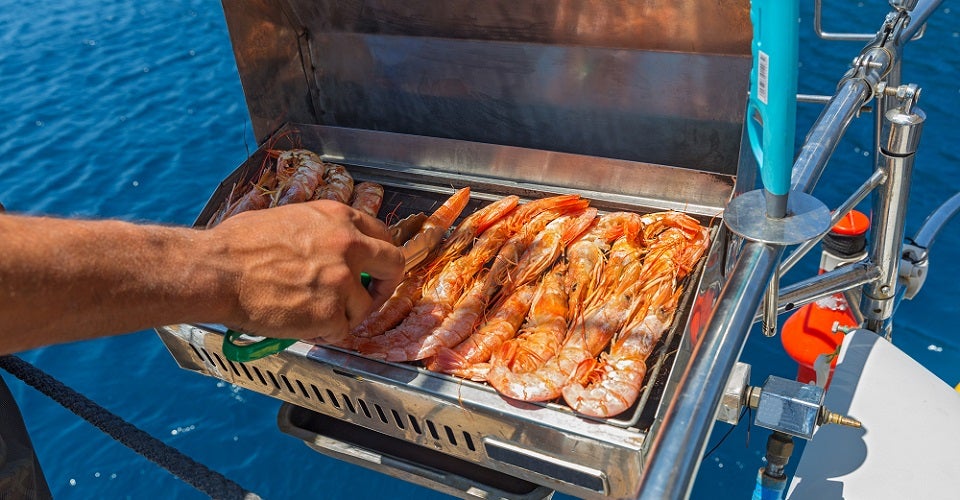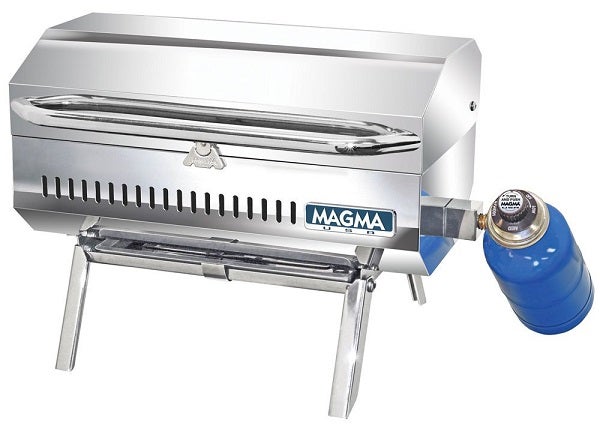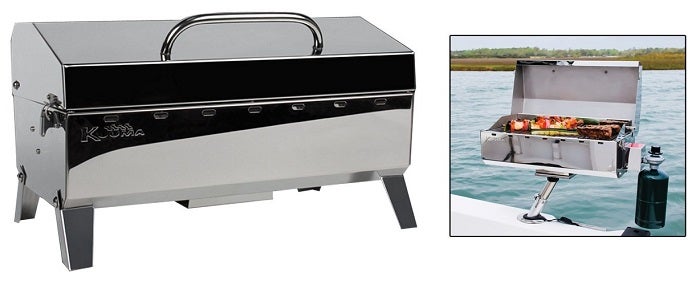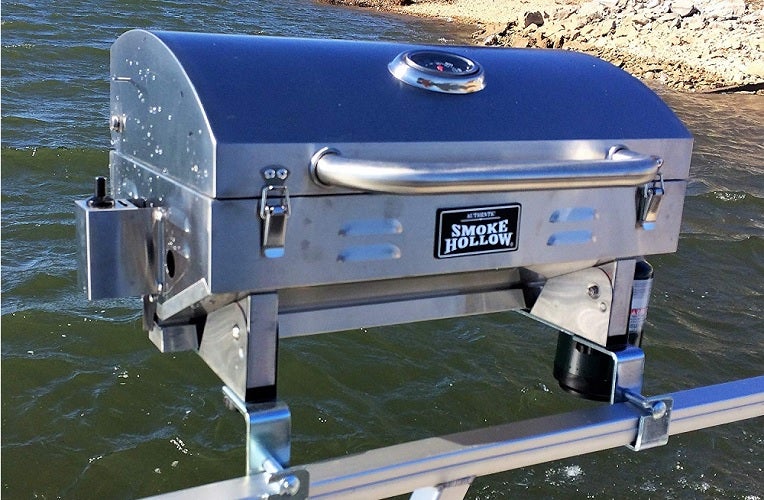
Our Editors independently research, test, and rate what we feel are the best products. We use affiliate links and may receive a small commission on purchases.
When summertime finally makes its way to us, we all want two things – boating, and grilling. Summer just wouldn’t be the same without the smell of a good bbq drifting across the lake.
It might be better, though, if you could grill on your boat!
Boat grills come in many sizes, shapes, and varieties so we’ll cover everything you need to know in order to get started picking out the right one for your summer style.
Best Boat Grills
For more of my marine gear recommendations, have a look through these popular Outside Pursuits guide links: Marine GPS, Marine Binoculars, VHF Marine Radios.
Quick Answer: The 5 Best Rated Boat Grills For 2021
- Magma Marine Kettle Gas Grill
- Magma Products Conniosseur Gas Grill
- Extreme Marine Products Cuisinart Grill
- Smoke Hollow Grill Modified for Railings
- Kuuma Stow and Go Propane Mountable Grill
Our reviews of the top rated boat grills with our comparison table and buyers guide will help you choose the right grill for your boat.
Boat Grill Reviews
#1 Magma Marine Kettle Gas Grill
- Boat Mount Style: Rod holder
- Cooking Area: 227 sq inches
- Material: Stainless steel
- BTUs: 10,700
First on our list is a small stainless steel grill that’s an awesome option for sport boats and fishing boats cooking for a small number of people.
It runs off a small 1lb propane or natural gas cylinder and comes in two sizes. While it may not be as hot as lava the Magma is, perhaps, the best marine grill on our list.
It’s lightweight and small in either 15” or 17” diameter models. Some users do note, however, that the Magma grill does pump out a ton of heat for its size.
Be prepared to do a little adjusting in order to find the right temperature for your grilling.
Two nice features are available on this model that I think is worth noting. First, the lid is hinged and attached at a central pivot point.
This gives great access to the entire cooking surface. Additionally, before lighting the grill you can rotate the lid itself to align it as a windscreen when open, reducing the chances of a blowout.
Note: For some reason, the manufacturer sells the grill mount separate from the grill so be sure to add it to your cart when checking out!
Best for grilling with small groups on sport or fishing boats.
#2 Magma Products Conniosseur Gas Grill
- Boat Mount Style: Multiple
- Cooking Area: 162 sq inches
- Material: Stainless steel
- BTUs: 11,200
One of the best boat grills out there today is the Magma Connoisseur. This nice-looking stainless grill is small, stout, and customizable with accessories and mounts for just about any boating situation.
Don’t be fooled – while the 162 square inches may seem smaller than the Magma Kettle it’s misleading.
Circular grills like the Magma can be difficult to efficiently use all the space near the round edges. With the ChefsMate you get a rectangular construction that can be easier to manage space.
Like the Magma, you’ll want to be sure that you buy the correct aftermarket grill attachment for your grill. Options include railing mounts or rod holder mounts.
This model features an inner safety shell which helps reduce overall outer temps and improve overall efficiency. Additionally, there’s a full-length stainless steel handle that runs the front of the grill.
Worth mentioning is the locking lid and removable grease tray which helps ease cleanup worries to almost none.
Best for a more conventional grill shape on small boats with flexible mount styles.
#3 Extreme Marine Products Cuisinart Grill
- Boat Mount Style: Railing
- Cooking Area: 145 sq inches
- Material: Coated & Stainless Steel
- BTUs: 5,500 BTU
Cuisinart makes some of the most recognized home and cooking products on the market.
Extreme Marine is here to make sure those products can get on your boat with the Arnall’s Grill Bracket to secure this portable propane grill to your pontoon deck railing.
First, let’s cover the base grill – a Cuisinart CGG-180T which cranks out 5,500 BTU over 145 square inches. It’s definitely less hot than the Magma Products but that might work out better for slow cooking and control of flame temperature for cooking.
Because this grill is one of the most popular portable grills on the market right now, Extreme Marine has come in with a customized pontoon railing bracket from Arnall for attachment and security on 1.25” pontoon railing.
Four thumbscrews hold the bracket to the grill and two square clamps keep everything tied down to the railing.
This grill is very small and it’s ideal for high portability and occasional use. Due to the design of the brackets, the entire grill also stands out over the edge of the boat which frees up maximum deck space.
Best for those who want a very small pontoon-mounted portable grill for occasional use.
#4 Smoke Hollow Grill Modified For Railings
- Boat Mount Style: Railing
- Cooking Area: 305 sq inches
- Material: Stainless Steel
- BTUs: 12,000 BTU
Smoke Hollow makes some high-quality stainless steel portable grills that are perfect for marine use.
This one happens to be one of the larger of the portable marine-worth grills from Smoke Hollow modified with the same Arnall brackets as the Extreme Marine grill we just looked at.
As we’ve seen before, the Arnall bracket uses thick stainless steel in a square 1.25” bracket for mounting to standard pontoon rails.
On top of that lives the Smoke Hollow gas grill for boats. This grill has a large surface area that’s enough for bigger gatherings (within reason).
Compared to most other boat grills, however, this model is substantially larger so it’s ideal for those who often cook on the boat or run with crowds.
A couple of features that really put this one more on the “deluxe” side is the push button ignition, locking lid, 100” chrome plated warming rack, and a 200” cooking grid.
It’s worth noting that there are a couple of different brackets that will fit this model such as the Arnall Universal Grill Bracket System to accommodate different boats.
Best for large parties or regular cooking on boats with pontoon style railings.
#5 Kuuma Stow and Go Propane Mountable Grill
- Boat Mount Style: Multiple
- Cooking Area: 160 sq inches
- Material: Stainless Steel
- BTUs: 13,000 BTU
Kuuma’s 160-series portable/mountable grills are nice stainless steel marine grills that can keep up with you by land or sea.
With a moderate price tag and robust features, it’s a solid option for a wide range of marine grillers.
Starting with the briefcase-style boat bbq grill, you’ll have a nice locking-lid stainless steel grill that can be adapted to many situations.
The grill itself has folding legs for use on existing surfaces like tabletops, picnic tables, or the ground.
On top of that, you will want to add the correct mounting bracket for you. You can choose from pedestal mounts, rod holder mounts, or railing mounts. That makes this grill one of the most versatile options on our list in terms of compatibility.
This one is ready to run with 1 pound propane canisters, but if you go to the Kuuma website you can find fittings for just about any type of European or American gas type.
Best for ultimate versatility in setup and running options with a smaller grilling surface.
Boat Grill Comparison Table
| Marine Grill | Mount Style | Cooking Area | BTUs | Rating | |
|---|---|---|---|---|---|
| Magma Marine Kettle Gas Grill | Rod holder | 227 sq inches | 10,700 | 4.4 / 5.0 | |
| Magma Products Conniosseur Gas Grill | Rail or Rod | 162 sq inches | 11,200 | 3.9 / 5.0 | |
| Extreme Marine Products Cuisinart Grill | Railing | 145 sq inches | 5,500 | 3.9 / 5.0 | |
| Smoke Hollow Grill Modified For Railings | Railing | 305 sq inches | 12,000 | 4.9 / 5.0 | |
| Kuuma Stow and Go Propane Mountable Grill | Rail or Rod | 160 sq inches | 13,000 | 4.2 / 5.0 |
How to Choose the Best Boat Grill for You
Now I’ll take you on a deep-dive to figure out what features are right for you so you can shop smart when it’s time to start grilling!
Grill Construction Materials
Marine grills are subject to several highly corrosive forces. Like normal grills, they get grease, oil, and food residue that can be quite caustic on the material of the grill itself. These grills also experience the effects of high heat and fuel-burning which by itself is another corrosive factor on the grill.
Unlike normal grills, however, marine grills are subject to regular water exposure. As anyone with a car knows, water exposure over time leads to rust.
In order to combat the effects of the freshwater spray, saltwater spray, and rainwater I recommend sticking with full stainless steel construction or aluminum construction. While stainless can eventually rust it’s much more resistant than materials like coated steel.
By far the most popular material for boat grills is stainless steel so we’ll stick to that as our preferred material!
Cooking Surface Area and Grill Size
Sooking surface are is the sum of all the available area on your grill for cooking food at any given time. Usually, this also includes accessory burners and side burners.
Typically, size restrictions are virtually null because grills can be used and stored outdoors on a driveway or patio. However, with boat grills, the game changes a bit.
Large grills can (partially) often take up valuable space on already cramped boats. In addition, a large or heavy grill is a real pain to take in and out of the boat if you use a non-permanent fixture. Therefore, I recommend strongly considering the smallest grill and cooking surface possible for your needs.
Unfortunately, with boat grills, the small size of most boats contradicts the larger size of grill needed to conveniently cook for 4-6 people (or more) on the boat.
Often 400 – 500 square inches of cooking surface is the recommended minimum for a standard household. For entertaining larger groups cooking size up to 600 square inches isn’t unreasonable under normal circumstances.
Unfortunately, most grills small enough to be reasonable portable or fit on a boat are usually about 100 – 300 square inches.
All that said, it’s up to you to find the balance between size and space. If you’ve got a large pontoon you may have room for a large grill. Portable grills on a sport boat, however, might need to be much smaller.
For most people, I’d recommend looking for a portable grill between 100-250 square inches as a reasonable size for most boats.
Attaching a Grill to Your Boat
Really, the sky is the limit when it comes to attaching your grill to your boat. However, most commercial models use one of about three different attachment methods.
Rod holder mounts use existing or additional rod holders on the gunwales of the boat to hold your grill in place. This keeps the grill solid and stationary but also allows the grill to be held at or beyond the edge of the boat itself to free up deck space.
Pedestal socket mounts are great for boats with existing flush mount sockets for movable seating. Most bass boats and fishing boats have this type of seating socket in the floor. Maybe the biggest drawback of this style is that the grill is fully inside the boat and consumes a substantial amount of floor space.
Railing mounts are usually used for pontoon boats with open rails. These mounts use clamp brackets to clip on securely over the edge of the pontoon boat rail. Usually, this puts the grill at a great height for use and also keeps it entirely outside of the boat so no one burns themselves and the additional floor space is kept open.
Of course, your last option would be to simply use a portable grill on an existing flat surface of your boat. However, since the boat is moving and people are likely walking around this presents an extreme safety hazard and we advise against it.
Grill Heat Output BTUs
BTUs are a measure of raw heat energy output. Basically, the more BTUs, the hotter your grill is going to get.
Of course, there’s a limit to how hot a grill really needs to get in order to be effective. I mean, you could try to cook a steak on the surface of the sun but it might not go so well, right? Same is the case with an overly-hot grill.
While it’s really up to you exactly what you choose, it’s probably best to stick with about 90 BTUs per square inch of grill space. So, if you have a 200 square inch grill, you’ll want 18,000 BTUs or so.
Some argue that as low as 70 BTUs or as high as 120+ are all acceptable. Take it with a grain of salt and probably stick around 80-100 BTU range to be safe.
Look for these rough numbers:
- 100 sq inches – 9,000 BTU
- 150 sq inches – 13,500 BTU
- 200 sq inches – 18,000 BTU
- 250 sq inches – 22,500 BTU
- 300 sq inches 27,000 BTU
Grill Construction Quality
Maybe the first area that most grill manufacturers cut quality is in construction. We talked about materials earlier – remember that stainless steel is probably the most common and appropriate material.
That said, however, there are many factors that affect how well your grill performs in the real world.
In order to maximize the efficiency of your grill, to get the best performance out of the lowest possible BTUs, you need a grill with a good tight fitting lid. Gaps or slop around the lid is a primary source of heat loss and inefficiency which wastes gas and heat.
Another efficiency and safety factor to consider is a dual-wall grill. Dual wall grills have an inner shell with a small gap separating the outer wall. This insulated gap helps keep the outer portion of the grill a bit cooler and improves the heating efficiency of the grill overall.
One final factor to keep in mind is the grill grate size. Many smaller grills, particularly those used for portable models that often are used in marine applications, have small or weak grates. Whenever possible I look for the thickest stainless steel grates I can find.
Thicker grates stand up to heat better over time and help add a lot of stability to your cooking surface. Thin grate wires tend to get deteriorated or rusted out quickly due to the high heat of the grill flames.
FAQs About Marine Grills
Q: How many people can I feed with my grill?
A: This really depends on what you’re cooking and how you’re cooking it.
That said, I’ll give you some rough ballpark options to work with.
For small meals – like a single hamburger per person, you should be able to get away with 40-50 square inches per person.
As soon as you add in extras, like a hamburger and grilled onions or potatoes, you should probably factor in about 60-75 square inches per person.
That said, however, you should always cook in batches. Cook the veggies first, then cook all the meat. Yes, it will take longer, but with small grills, it’s often the only viable option.
Q: Can I leave my grill permanently attached to the boat?
A: You can… but probably should not.
Even stainless steel grills have components that are often susceptible to degradation from elements.
For instance, rubber hoses, washers, and o-rings often used in gas fixtures tend not to hold up well over time if left to UV exposure due to sunlight. For that reason, I recommend at least covering your grill if you’re going to leave it stored outside for the summer boating season.
During the winter you should definitely detach your grill unless your boat is stored inside.
I’d also detach the grill when transporting the boat because it could be damaged in transport by shock, vibration, or accidental physical damage.
Q: My grill keeps blowing out in the wind, what’s up?
A: First thing’s first, make sure you have a full propane bottle. Bottles with low pressure will struggle to stay lit in even a small breeze.
If your propane is good, then it’s time to look for a baffle or airflow venturi. Often there are adjustable airflow controls somewhere on the propane inlet or around the burner. Check under the grill where the propane goes in.
Consult the operator’s manual for adjustment guidelines if needed.
Additionally, look for other adjustable vents on the top, sides, and bottom of the grill. Slide these closed to help reduce wind gusts.
If all of that doesn’t help then you may need to relocate the grill to an area of the boat that has a little bit of wind block like behind the wheelhouse if available.
Q: How long will a bottle of propane burn for?
A: There’s a bit of math involved here but you’ll need to know a few things.
- How much propane is in your bottle
- How much heat energy that propane contains
- How many BTUs your grill runs at
If you have a 10,000 BTU grill (typically this means that it releases 10k BTUs per hour) and a one-pound propane tank and…
One pound of propane is approximately equal to .24 gallons of fuel and…
Each gallon of propane contains approximately 95,000 BTUs of energy then…
A single one pound propane tank contains about (95,000×0.24) = 22,800 BTU so…
A 10,000 BTU grill can run on a one-pound propane canister for (22,800/10,000) = 2.28 hours or 137 minutes at full power.
To find the run time of your grill at max power, simply take 22,800 and divide it by the BTU output of your grill.
I borrowed heavily from the data provided by Foster Fuels for these numbers.
Note: Remember, if you run your grill at half power the entire time, expect your propane to last twice as long and so forth.
Q: Can I make my own mount for a boat grill?
A: Absolutely!
Many marine suppliers have rod holders, rod holder mounts, brackets, pedestal seat brackets, and other clamps for universal mounts on most boat styles. All you have to do is shop around and get creative.
If you don’t want to modify your grill or your boat, however, you may be further ahead to choose from one of the grills on our list that are premade or pre-modified for this very purpose.
Outside Pursuits Overview
When it all comes down to it, taking a grill out on your boat is probably the best way to combine two of the most relaxing activities mankind has ever dreamed up. Finding the space, right grill, the correct mounting brackets, and putting it all together, however, can be a trick.
In today’s article, I’ve tried to cover as much as I can about what to look for and what to avoid. You should be able to figure out what size to get, how long it can run for, and how or where to mount the grill on your boat.
Remember to revisit the FAQs and “how to buy” section to get your questions answered. Then, check out our review’s of this year’s best boat bbq grills and get out on the lake!
How We Researched
To come up with the top marine bbq grills we researched a variety of sources for reviews such as REI, Dicks Sporting Goods, Cabelas and Backcountry along with our own personal experience.
We also consulted online magazines for product research and reviews to get as much unbiased information as we could. To help weed out fake reviews we used Fakespot.com to make sure we only looked at genuine reviews.
With so much quality gear available, we had to narrow it down based on what we felt were the best options for the price. The author, Casey Fiedler has been an avid boater for over 10 years.
To help narrow down the selection he used his personal experience along with recommendations from boat captains and fellow boaters.
After extensive research, we came up with our list to help you choose the right one for you.




Magma’s boat grill has taken a good barbecue and made it better. The top is no longer removable, connected only by a tether. Now it is permanently attached and swivels open. While this barbecue seems small, it actually has a fair-sized cooking surface, partly because there are no back corners that are cold areas, it is all evenly heated and fully usable.